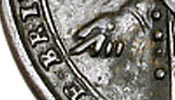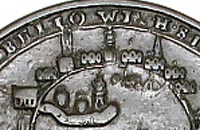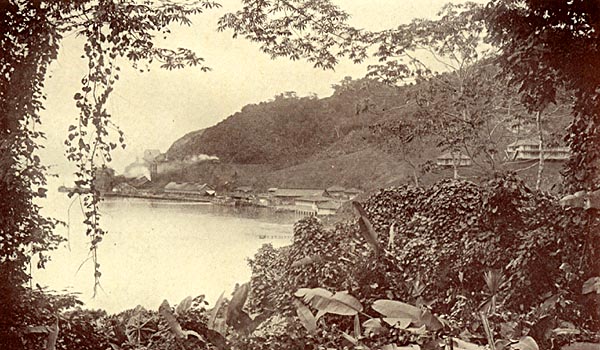| Obverse Design | Legend curving above says "THE o BRITISH o GLORY o REVIV o D o BY o ADMIRAL o VERNON". There is an inside line enclosing the legend. In the center is a half length figure of Admiral Vernon with his body half turned to our left, but his head fully facing forward. Vernon is holding a baton in his left hand, and his right hand is pointing with one finger at the letter "B". The figure of Admiral Vernon goes all the way to the bottom edge of the medal. The medal has a smooth plain raised edge. | ||||
| Reverse Design | Legend curving along the top says "WHO TOOK PORTO BELLO WITH SIX MEN OF WAR ONLY". There is an inside line enclosing the legend. In exergue (under a line along the bottom of the medal) it says: "NOV . 22 . 1739 .". There are no ornaments below the date. The center is the attack on Portobello. The six ships are lined up two and four, with the fourth one on the bottom row a little higher than the other three. Five ships are sailing to our right, and the bottom right-most ship is sailing to our left. There are two boats in the harbor. There are water lines outside the harbor. A tower points at the second letter "L", and steeples at the letters "W" and "H". The medal has a smooth plain raised edge. | ||||
| Distinctions | There are a lot of varieties with a half-length Vernon as the main obverse design. Of those, about 16 have Vernon pointing near the "B" of "THE BRITISH GLORY REVIVD..." legend. Six of those 16 have the "MEN OF WAR" legend on the reverse. This is the only one with the spires at the second "L", "W" and "H". | ||||
| Detail On Obverse of VN-2.67 | Detail On Reverse of VN-2.67 | ||||
 Note Vernon's finger pointing at the letter "B". |
 Note the spires at the second "L", "W" and "H". Also note the two boats in the harbor. |
||||
| Metal | Copper. | Weight | Unknown. | Size and Shape | Round, 36.5 mm in diameter. |
| Rarity | Common. | Designer or Issuer | Not known. | Other Catalog Numbers | McCormick-Goodhart #59, Betts Unlisted. |
| Notes |
The photo below shows the site of the once feared "Iron Fort" around 1913. With no regard for the fort's historical value, the American Canal Builders turned the ruins of the fort into a rock quarry for the canal effort. The Panamanian government protested the action, but was too late to save the fort. |
||||

From Our Canal in Panama by Emory Adams Allen